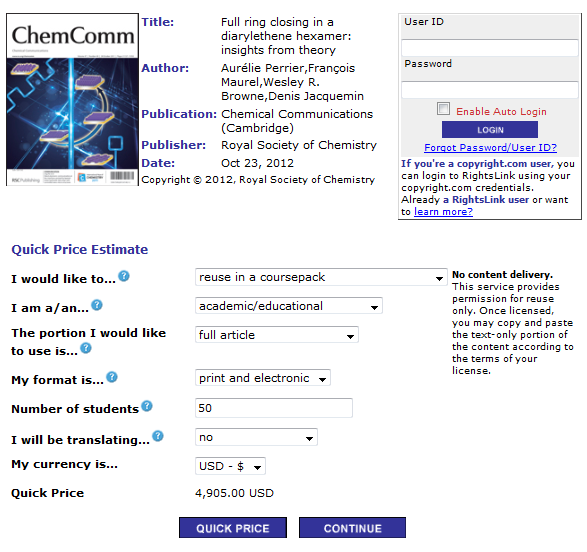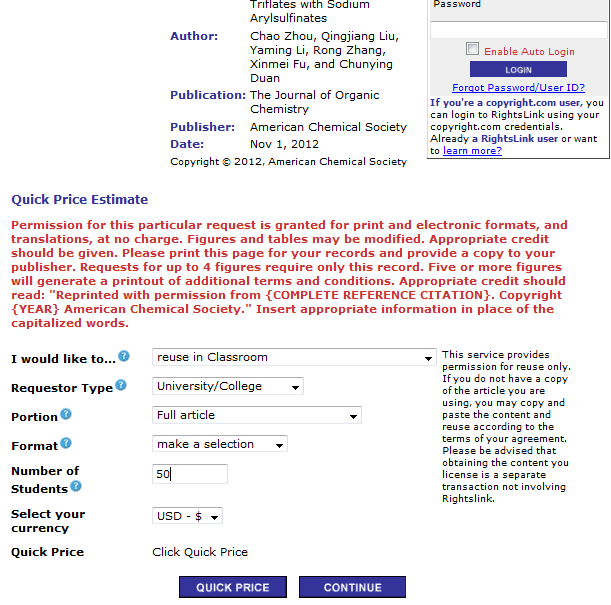There has been considerable debate about the charges of ACS journals and SUNY has made headlines in “Walking away from the American Chemical Society” http://www.attemptingelegance.com/?p=1765 where they intend to cancel subscriptions to the ACS and use Royal Society Of Chemistry material instead. [*]
However I imagine SUNY know what they are doing and they may say – for teaching it doesn’t matter what exact examples we pick. But are RSC cheaper? Quite by chance I was investigating their new “Gold for Gold” product and discovered that they were charging for Open material (/pmr/2012/11/06/royal-society-of-chemistry-will-charge-students-for-re-using-gold-open-access-articles/ ). Richard Kidd has explained this as a “bug” For me “bug” is not an excuse for charging for Open. I will return to this in a later post. But what shook me was the prices.
To check it wasn’t due to the “Open” “bug” I went back to a Closed RSC article (i.e. one I can’t read and have to pay for). I chose the journal Chemical Communications because the papers are short (max 2 pages, I think) and very much the sort of thing that someone (in SUNY, say) might use in a course pack. So I went to the “Request permissions” button and simulated being an academic with a class of 50 students and creating both electronic and printed material, one copy for each student. This is a very common type of operation in teaching. I requested the whole article (it doesn’t make sense to have less than the full article if it’s only 2 pages). Here’s the quick price:

I have checked I haven’t got numbers, currency, etc. wrong.
The RSC will charge EVERY student ONE HUNDRED DOLLARS for a TWO-PAGE article. (And it’s the students who pay – there is no fairy godmother).
By comparison I went to the ACS. I found a recent article (probably several pages – *I* can’t read it – it costs 35USD). I went through the same process. (the fields are different but sufficiently similar:

NO CHARGE. So what the ACS makes available for free, the RSC charges nearly 5000 USD for.
The story speaks for itself.
Hi Peter
Again, thanks for the opportunity you’ve given me to find out more about how our rights system works.
First thing’s first: our subscribers have the rights for educational use under the terms of their contract. So if they can access the papers, they have the rights to use for teaching.
The reason why this hasn’t been spotted is we get zero traffic for educational reuse requests through this route (possible not surprising with that list price attached, you may rightly think).
The OA bug we can fix with a change to our platform to replace the Permissions link. This one looks like a default setting for educational use we need to sort out with RightsLink (I might be wrong here, just want to explain what the fixes probably are). Both of these will be looked at by the proper people here.
Summary:
• We don’t charge for educational reuse rights by subscribers
• We haven’t received any money for the example reuse rights this year (that’s the most I can check to get a quick response out)
• But we’ll get these unpleasant bugs fixed – but no-one’s been affected by them (apart from isolated distress to you, and less importantly, me)
Best wishes
Richard
Thank you for the factual position.
I hope to address this and other publisher issues shortly. I agree strongly with what Mike Taylor has written.
Pingback: www.palaeontologyonline.com | Article: Life as a Palaeontologist > Life as a Palaeontologist: Academia, the Internet and Creative Commons
Pingback: Unilever Centre for Molecular Informatics, Cambridge - Institutional Readerism: The Royal Society of Chemistry isn’t putting serious effort into “Open Access” « petermr's blog